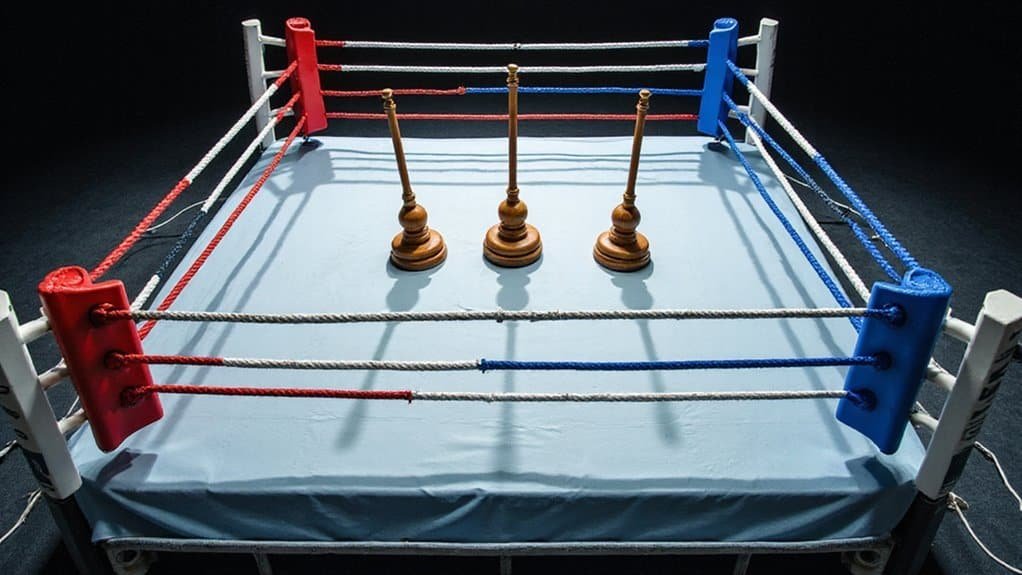A unanimous decision in MMA occurs when all three judges independently score a fight for the same fighter after the bout goes the distance. This represents the clearest form of judging victory, eliminating the controversy that often surrounds split or majority decisions. Judges use the 10-point must system, evaluating effective striking, grappling, cage control, and aggression to determine round winners. These decisive outcomes markedly impact fighter rankings, contract negotiations, and future matchmaking opportunities within the sport.

A unanimous decision in mixed martial arts represents the clearest form of victory when a fight goes the distance, occurring when all three judges independently agree on the same winner. This outcome eliminates the controversy often associated with closer contests, providing an unambiguous result that typically satisfies both fighters and fans.
The judging system relies on three appointed officials who evaluate each round using the 10-point must system. Under this framework, the round winner receives 10 points while the losing fighter typically earns nine or fewer points. In rare instances where a round appears completely even, both fighters may receive 10 points.
Each judge works independently without consulting colleagues, guaranteeing their scorecards reflect individual assessments rather than group consensus. Judges evaluate multiple criteria when scoring rounds, focusing primarily on effective striking and grappling.
Striking encompasses punches, kicks, elbows, and knees that land cleanly and cause visible impact. Grappling effectiveness includes successful takedowns, submission attempts, and position reversals that demonstrate control over an opponent. Additional factors include cage control, forward pressure, aggression, and defensive capabilities.
The positioning of judges around different angles of the cage ensures thorough coverage of the action. Their scores remain confidential throughout the fight, preventing external influence or pressure that might compromise their objectivity. This system maintains the integrity of the judging process while allowing each official to focus entirely on evaluating the techniques and strategies displayed.
Unanimous decisions contrast sharply with split decisions, where two judges favor one fighter while the third selects the opponent. Majority decisions occur when two judges agree on a winner, but the third judges the contest as a draw. These alternative outcomes often generate debate and discussion, while unanimous decisions typically face less scrutiny due to their clear consensus.
The impact of unanimous decisions extends beyond the immediate fight result. These outcomes influence fighter rankings, contract negotiations, and future matchmaking opportunities. They provide definitive conclusions that help establish clear trajectories for athletes’ careers, particularly in title contention scenarios.
Modern mixed martial arts has evolved considerably from early combat sports that relied solely on stoppages to determine winners. The introduction of judges and formal scoring systems created opportunities for technical fighters to demonstrate superiority without requiring knockout power or submission expertise. To achieve a unanimous decision, fighters must display consistent dominance across every round throughout the entire contest. However, even unanimous decisions can face scrutiny when controversial unanimous decisions spark discussions about judging and scoring accuracy.
Unanimous decisions have become the most common type of official decision in contemporary MMA, reflecting the sport’s maturation and the effectiveness of current judging protocols in producing clear, defensible outcomes that accurately reflect fight performances.
Frequently Asked Questions
Can a Unanimous Decision Be Overturned After the Fight?
Yes, a unanimous decision can be overturned after a fight, though it’s infrequent.
Athletic commissions can reverse decisions following formal appeals that reveal scoring errors, misdeclarations, or rule violations like illegal substances or equipment tampering.
The process requires concrete evidence and official review. Most appeals based on subjective scoring disagreements fail, making successful overturns limited to provable cheating or significant clerical mistakes.
Do All Three Judges Score Every Round the Same Way?
No, the three judges do not score every round identically. Judges frequently disagree on individual round winners, creating “split rounds” on scorecards.
They interpret scoring criteria like effective striking and grappling differently, leading to varied assessments. A unanimous decision only requires all three judges to favor the same fighter overall after totaling round scores, not round-by-round agreement.
What Happens if One Judge’s Scorecard Is Lost or Damaged?
If one judge’s scorecard is lost or damaged, the bout outcome depends on the commission protocol.
Most sanctioning bodies may declare the fight a technical draw or no contest when scoring cannot be accurately reconstructed.
Some commissions attempt to recover the missing scores through judge recollection or unofficial notes.
In extreme cases, the result might rely solely on the remaining two judges‘ scorecards, though this varies significantly by jurisdiction.
Are Unanimous Decisions More Common in Title Fights Than Regular Bouts?
Unanimous decisions occur more frequently in title fights than regular bouts.
Championship matches feature elite fighters with superior defensive skills and tactical awareness, leading to fewer finishes. The five-round format increases decision likelihood, while higher stakes encourage risk-averse strategies.
Title fights also demonstrate greater judge agreement due to enhanced scrutiny and clearer performance differences between championship-caliber athletes.
Can Fighters Appeal a Unanimous Decision They Disagree With?
Fighters can appeal unanimous decisions, but success remains extraordinarily rare.
Appeals require submitting formal complaints with compelling evidence of scoring errors, official misconduct, or rule violations to athletic commissions.
Most appeals fail since disagreeing with judges’ subjective scoring isn’t sufficient grounds. Overturning requires concrete proof of procedural errors or serious misconduct—making successful reversals virtually nonexistent in MMA history.

